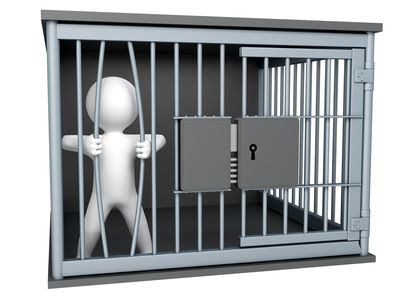
Now the environment is killing my trees?
Now we are to the GRAY AREA of plant health care. Diseases and insects can be confirmed to be killing a tree. Tests can be done to tell if a tree has a deadly fungal or bacterial disease but how can we tell if a tree is dying from something within its environment. Well the reason I say this is gray is because its all on observations. Sometimes environment may be the size of area that a tree or plant can grow within. If the area is too small the plant will either break out or it will die of starvation.
Now it might not be as extreme as the picture to the right but trees need space to grow larger. This becomes a big issue in city areas where space comes at a premium and many homeowners want to escape the city by having as much nature around as possible. The problem is that the root systems of the trees are invisible from where we see them and often they arent getting what they need.

Can water kill trees?
Studies have shown that 95% of newly planted trees die from overwatering. But how is that possible? The poor trees need water in their weakend state right?
What trees need is a root system to help the tree grow stronger. Adding a ton of water will only fill up air pockets in the soil and drown the tree. Of course a watering schedule should be set up to give the tree or plant the proper amount of water but heavy overwatering at the beginning when a tree is so stressed can be the death sentence for a tree. Instead, look into root growth hormones. They are similar in concept to fertilizer but most people who plant a tree know that fertilizing right away is a huge no no. Root growth hormones will help speed up the damage that has been done in the transplanting process. It also helps give the plant a proper root system that can naturally pull up essential water and nutrients for the plant.

This is a popular root growth hormone. Can be found at most nurseries and big box stores.
So many environmental issues!
When it comes to environmental issues in plants and trees there are almost too many to name and deffinitly a boring read unless you are truely interested in the topic of environmental studies and its effects on plant life. I will outline a few more that tend to be major contributors to plant decline or enable disease or insect infestation of plant life.
Salt stress often happens in areas where snow or ice occur and roads or pathways are salted to keep the areas from beign slick. The problem is runoff of the salts keep water from being absorbed through the root system. Just like eating a salty snack makes you thirsty same goes for the plants.
Nutrient difficiencies may be one of the most common issues that happens in plant life that is planted by humans. In most cases proper mending of soil has not been done or proper research/soil testing done to know what the plants will need within the area they are planted. Knowing your soil immediately gives you the one up on planting and maintaining plantlife on your landscape.
Competing plants may fight over the nutrients that your trees or plants need. The most common form of this in Texas is ball moss. Its almost hard not to spot this invasive pest within your trees. What it is doing is latching onto the tree and leaching the nutrients out of it. It is considered a parasite of trees. Sometimes competeing plants may not be all that noticable though.
Improper pruning techniques are the cause for many issues in trees including pest damage, fungal spread, structural integrity problems and many other issues. Its always important to know how a tree is supposed to be pruned. We at arbor doctor do not prune trees but understand the tree trimming standards set in place by ANSI and ISA.



